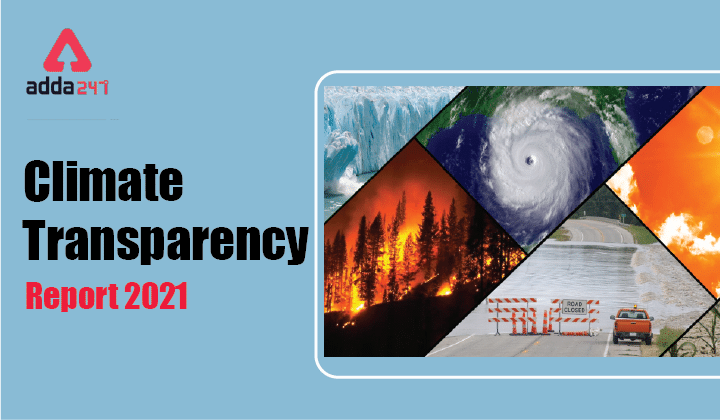Table of Contents
Climate Transparency Report 2021: Relevance
- GS 3: Conservation, environmental pollution and degradation, environmental impact assessment.
Climate Transparency Report 2021: Context
- Recently, Climate Transparency Report released by Climate Transparency to provide a comprehensive overview of G20 countries on their journey towards a net-zero emissions economy.
Climate Transparency Report 2021: Key points
- The report draws on the latest emissions data and covers 100 indicators on decarbonisation, climate policies, finance and vulnerability to the impacts of climate change.
- The review is based on 100 indicators for adaptation, mitigation and finance and aims to make good practices and gaps transparent.
Climate Transparency Report 2021: Key findings
- Canada, France, EU and Germany are identified as ‘current leaders’ of the green recovery.
- Non-OECD G20 members face greater challenges to rebuild after multiple crises, having to grapple with chronic problems and inequalities such as access to funds, debt constraints and extreme poverty.
- Global warming will reach or exceed 1.5°C in the early 2030s in nearly all emissions scenarios considered by IPCC AR6.
G20 emission
- G20 is responsible for around 75% of global greenhouse gases (GHGs) including land use change and forestry.
- The combined mitigation effect of Nationally Determined Contribution (NDC) targets assessed by April 2021 is not sufficient and will lead to warming of 2.4°C by the end of the century.
- The UK is the only G20 member with a domestic target that aligns with a 1.5°C modelled domestic pathway in 2030.
Fossil Fuels
- The G20 has continued to pour money into the fossil fuel industry, with a total of USD 298bn committed in subsidies from January 2020 to August 2021, which is almost equal to the G20’s total green recovery allocation of USD 300bn.
Energy sector
- CO2 emissions from the energy sector make up 78% of all GHG emissions (including land use change and forestry), with the highest proportion coming from the power sector.
Net Zero targets
- Canada, the EU, France, Germany, Japan, South Korea and the UK – together accounting for 14% of global GHGs – have enshrined their target in law.
Climate Transparency Report 2021 India
- On the other hand, Australia, India, Mexico, Russia, Saudi Arabia, Turkey have not announced any target till now.
Ambition Gap
- The Ambition gap is the gap between the NDC and the 1.5°C compatible range as modelled by the 1.5°C National Pathways Explorer.
CAT rating
- The CAT rating here is a new, overall rating that combines several separately rated elements of policies and actions, domestic and internationally supported targets, ‘fair-share’ target and contribution to climate finance.
World Social Protection Report 2020-22
Climate Transparency Report 2021: Suggestions
- G20 members that have not yet done so need to adopt mid-century net zero targets that are embedded in law.
- G20 members that are still supporting fossil fuel industries need to redirect subsidies towards sector transformation and investments in renewable energy and other green sectors.
- Power: Further stimulate and scale up growth in renewables whilst committing to a rapid phase-out of fossil fuels.
- Transport: Introduce policies and measures aimed at fuel switching to low-carbon fuels, mass electrification and modal shifting. Sales of internal combustion engine (ICEs) vehicles should be banned by 2035 to limit temperatures to 1.5°C.8
- Agriculture: Global deforestation needs to be halted and changed to net zero CO2 removals by around 2030
- Methane emissions (mainly enteric fermentation) need to decline by 10% by 2030 and by 35% by 2050 (from 2010 levels). Nitrous oxide emissions (mainly from fertilisers and manure) need to be reduced by 10% by 2030 and by 20% by 2050 (from 2010 levels).
About climate transparency partnership
- Climate Transparency is a global partnership with a shared mission to stimulate a “race to the top” in climate action in G20 countries through enhanced transparency.
About climate transparency countries
- AMERICAS: Argentina, Brazil, Canada, Mexico, The United States.
- EUROPE: European Union, France, Germany, Italy, Russia, The United Kingdom, Turkey.
- AFRICA AND MIDDLE EAST: Saudi Arabia, South Africa.
- ASIA: Australia, China, India, Indonesia, Japan, South Korea.
- NON-G20 COUNTRIES: Colombia, Nigeria, Philippines.




 TSPSC Group 1 Question Paper 2024, Downl...
TSPSC Group 1 Question Paper 2024, Downl...
 TSPSC Group 1 Answer key 2024 Out, Downl...
TSPSC Group 1 Answer key 2024 Out, Downl...
 Cabinet Ministers of India 2024, New Cab...
Cabinet Ministers of India 2024, New Cab...







